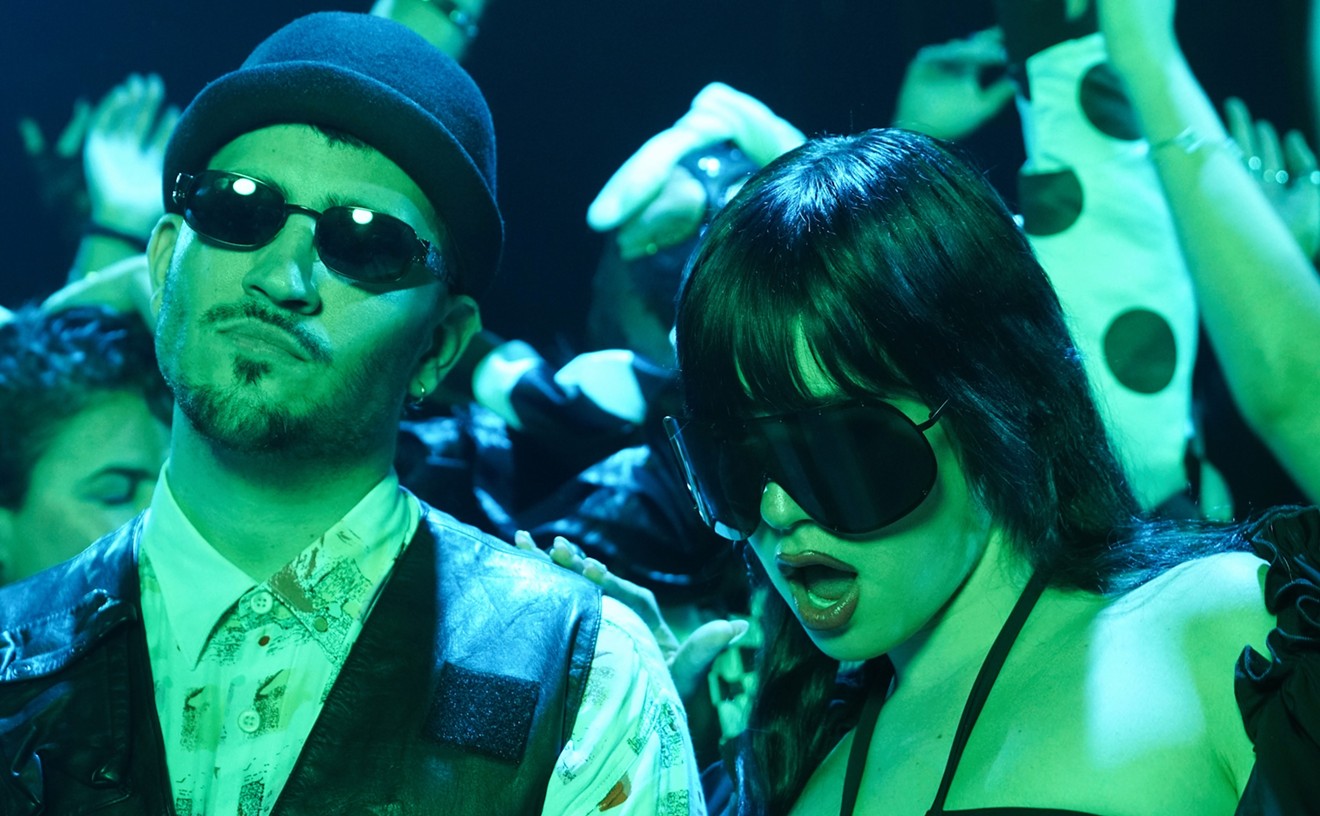His usually slicked back hair is a tussled mess from the gust blowing off the dim bay. He's taking a break from planning a second tour in support of Home, A Kite Is a Victim's debut release on Space Cadette Records.
The twelve-track, 73-minute disc is not the sort of record a major label would likely release from a debut artist. Half the songs on Home are more than six minutes long; a couple are ten-plus minutes. Galvez's abstract, soul-searching lyrics, set against a backdrop of melancholy guitar strumming, don't make for easy sing-alongs. Neither does Galvez's voice. At times he mutters the lyrics as if he were lying in his sick bed with a 103-degree fever; other times he flat-out wails.
Although A Kite has been around for four years, the lone constant in the band has been Galvez. He assembled the members as more of a loose collective than a band, one dedicated to recording a cycle of the deeply personal songs he'd been compiling. On Home, Galvez is backed by a shifting cast of musicians who play everything from strings to oboe, saxophones, slide guitar, keyboards, and the traditional drums-bass-guitar core.
The disc is above all an ambitious collection, and this ambition is even reflected in the elaborate handmade package, which features Galvez's artwork. "I've completed a package with Space Cadette that only someone like Madonna could get from a major label," Galvez notes.
Of course, it can only help matters that Galvez co-owns Space Cadette, a South Miami record label/studio he runs with his brother, Rafael. This fact might also explain why Galvez, a notorious perfectionist, was allowed more than a year to produce Home.
But there's actually a better explanation for the delay: Galvez has been a very busy fellow. In addition to overseeing a multitude of music and visual art happenings at Space Cadette, Galvez and Rafael produce "Barcode," a community underground dance and arts television show for WAMI-TV (Channel 69). And then there is Galvez's other band, the Latin-rock outfit Enemigo Sol, which is currently negotiating a contract with a Colombian record company.
Despite a schedule that would give the Pope a run for his money, Galvez says there's no question where his priorities lie: "A Kite Is a Victim is what I truly love. It's where I really feel home."
The experience of recording Home, though, was a decidedly tough affair. Because the band had no money to record, they had to use Space Cadette's studio during the hours when it wasn't booked by other bands. This meant an erratic schedule, ranging from days of no recording to marathon cramming sessions that lasted hours on end.
The process was so arduous that the core group of musicians who recorded the album with Galvez has since left the band. Scott Nixon, frontman and guitarist for local rockers Ed Matus' Struggle, contributed back-up vocals and played guitars and piano on Home, and even co-wrote a song ("Home to Your Ghost") with Galvez. "We started recording in May 1997 and didn't finish until July 1998," says Nixon.
Nixon recalls sessions that lasted as long as twelve hours. "I couldn't do it. I felt I was shortchanging them," he says. "It was a mutual understanding with Al that I wasn't into it as much as I should be, and it was draining him, too. I think that was the situation with everybody."
Galvez says his demands on the band were inevitable. "The vision for this album was to compose a masterpiece, to make every moment count. To make words like 'Promise, I will never be alone' hit you the way they should. I didn't sing that line a million times in my head so that I could just blurt out those words on the spur of the moment. That's bullshit. When you go see an Oliver Stone movie, the fact that you enjoy it is because there are details that are so soft and subtle, but it took a lot to brainstorm those simple, little things."
Galvez understands and appreciates his need to suffer for art. His band's name reflects the conflicts that arise between him and his music. "It's the title of a Leonard Cohen poem," he notes. "It's sort of a romantic image. The poem questions the roles between the man and the kite, asking who's holding the string? Who's pulling at who?"
The album saw its official release on October 2, at a CD release party at Space Cadette. The band performing as A Kite that night featured all new members except for Galvez: bassist Henry Rajan, drummer Ulysses Perez, and guitarist/saxophonist Marcus Ware. The group followed the party with a brutal, DIY three-week tour up the East Coast, as far north as New York and Boston.
With money drawn from A Kite's own reserves, the group managed to play daily, sometimes performing as many as three gigs per day. Galvez says advance planning and some on-the-spot networking helped make the tour a huge success. "I had a back-up plan for everything," he says. "If the tires go, I had four more in the back. If we don't get to this place, it's all right because we can stop at this place or go to this place. If one club's closed then we know of other clubs in the area that I can hit personally and ask if we can play that night, which actually happened a couple of times."
As daunting as the tour schedule was, Galvez says it was actually a positive experience, one that helped solidify the new lineup.
"It's his music," bassist Rajan says. "I understand we're playing something that's dear to him. As most musicians, we have our own ideas. There are times when he's pretty headstrong. I understand that because there are some times when I play something with one of my other projects and I have to say, 'Let's keep it this way for now, until we can get to that level where we can fuck with it.' I have to thank him for teaching me that."
The band is now gigging regularly at coffeehouses in South Florida, where they bring a case of CDs with them to sell to fans. Galvez is still arranging deals with distribution companies to get the discs into stores. For now, they sell to a demographically diverse group that surprises even him: "We get everyone from teenagers to seventy-year-olds approaching us to buy CDs."
The arrangements of the songs on Home might help explain this diversity. The album segues from the neo-country flair of The Eagles, to the lethargic, slow-core style of bands such as Red House Painters.
Galvez notes other influences as well: Nick Drake, Peter Gabriel, Jeff Buckley, Sting, Mark Lanegan, and Low. Opening the album is "Message Me Never Again," a song propelled by Galvez's soft guitar strumming and sympathetic snare taps courtesy of drummer Bruce Cowder. Leroy Talcott provides a bottom on fretless bass that holds up the rhythm, while meandering through the harmonic spectrum. As layers of cello tracks sigh a melodic chord, Scott Nixon's acoustic 6-string weaves a guitar lead that seems to embrace Galvez's gentle rhythm. The words come so softly and delicately, it's as if each one floats on a feather.
The songs maintain an intimate, soothing quality throughout the album. Any dynamic embellishments by electric guitars aren't allowed to overshadow the smoothness of the songs. The guitar solo on "Lily Pad Room" (provided by Juan Montoya of Ed Matus' Struggle) sounds like it comes from some distant transistor radio, and "Brand New Old Cars" fades in on a whirring wall of electric guitars that sounds like a howling wind. "Everything you need to know about me is in the lyrics and in the music," Galvez says.
His lyrics often chronicle the thoughts of a character mired in conflict. "Garden Boat" presents a protagonist who is cold and unfeeling ("How convenient it'd be to make you mine ... I ripped you from the ground to keep my pride"), yet terribly confused and isolated ("Why is everything ... so hard to explain. Time. How I wished for your garden boat to stay here forever."). "Festered Novelty" puts forward a character so anguished he seeks the comforts of drowning: "The ocean waters shake uneasy 'cause my escape will change their tides/ down from the depths of the murky, to the top of the blue sky/ They're going to hear my cry: I'm gone."
For all its ornate instrumental beauty, Galvez says he considers Home an expression of his need to find solace in simplicity. "In the end, after all this is stripped down, I just want to freeze everything and go back home," he concludes. "I just want to be lulled again. I just want all the insanity to stop. I want all the common sense to stop. I want my adulthood to stop. I don't want to be in control anymore. I want to be in a crib again."
A Kite Is a Victim will be performing Friday, December 11, at Power Studios' Studio A, 3701 NE 2nd Ave, 305-576-1336. The show starts at 10 p.m.; cover charge is $5.











